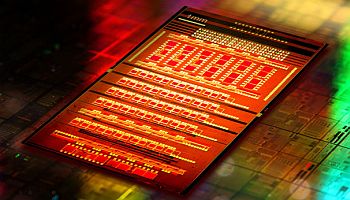IBM And Samsung Expand Chip Research Partnership

IBM and Samsung are co-operating in semiconductor technology R&D for mobile devices and other products
Researchers from Samsung Electronics are joining those from IBM and other partners in developing new semiconductor technology for a wide range of applications, from mobile computing through other high-performance scenarios.
Samsung, which has partnered with IBM in the past on semiconductor work, will now be part of the IBM-led Semiconductor Research Alliance, a group of vendors working together in R&D on process innovation.
Chipping In With Research Projects
 The move, announced January 12, will mark the first time that scientists from Samsung will work with colleagues from IBM and the other vendors at the Albany Nanotech Complex, according to IBM. At the facility, researchers look into new materials and transistor structures, interconnect technologies and packaging solutions for technology nodes.
The move, announced January 12, will mark the first time that scientists from Samsung will work with colleagues from IBM and the other vendors at the Albany Nanotech Complex, according to IBM. At the facility, researchers look into new materials and transistor structures, interconnect technologies and packaging solutions for technology nodes.
“Collaborative innovation will be critical if the semiconductor industry is to continue driving new forms of consumer electronics and new methods of computing,” Michael Cadigan, general manager of IBM Microelectronics, said in a statement. “That’s why we’re excited to have Samsung scientists working with us at the most fundamental stages of the R&D process.”
Along with IBM and Samsung, other members of the Semiconductor Research Alliance include Infineon Technologies, Freescale, GlobalFoundries, Renesas Electronics, ST Microelectronics and Toshiba.
“We are pleased to have our top-level scientists involved with the cutting-edge research that’s taking place at the Albany Nanotech Center,” said E S Jung, senior vice president of technology development at Samsung’s System LSI Division, in a statement. “This should further enhance our joint efforts to continue technology leadership well into the future.”
The continued shrinking of technology and devices is putting greater demand on semiconductor companies to drive innovation to make their offerings smaller while improving performance and energy efficiency. Fuelling that demand is the rise of such devices as smartphones and tablet PCs, as well as the growing embedded market. According to IBM, through such innovation, consumers will see devices that are smarter, continuously connected to the Internet and other devices, and increasingly mobile.
Company officials also pointed to various trends that are rapidly gaining steam, including the mobile Web and cloud computing, as well as the demand from users for greater performance and reliability, as well as enhanced energy efficiency.
Spreading The Cost Of R&D
The Semiconductor Research Alliance is a way for the companies to spread the high costs of such research and development. The group in April 2009 had announced their joint development of 28nm, HKMG (high-k metal gate) semiconductor technology aimed at mobile and consumer electronics applications.
The agreement signed by IBM and Samsung also renews the joint process development agreement between the two companies to create multiple nodes starting at 20 nanometres. The goal of that agreement is to create technologies for foundries to enable them to create high-performance, energy-efficient chips at 20nm and smaller.
Solutions for 20nm and smaller will be on display at the Common Platform Technology forum on January 18 in California. Common Platform is a foundry model created by IBM, Samsung and Globalfoundries. More details about the forum can be found at Common Platform’s Website.